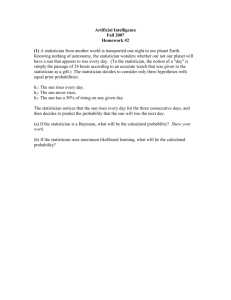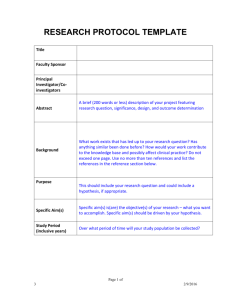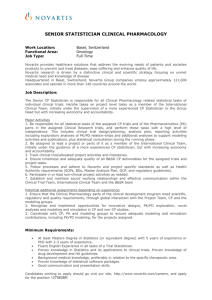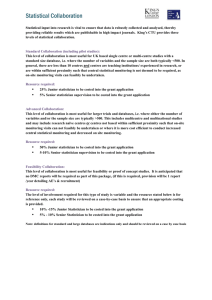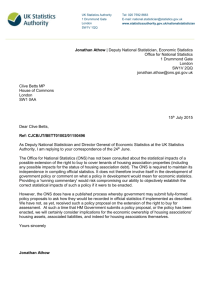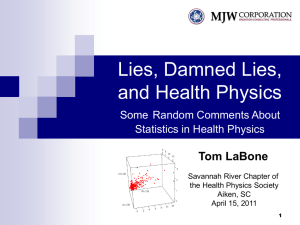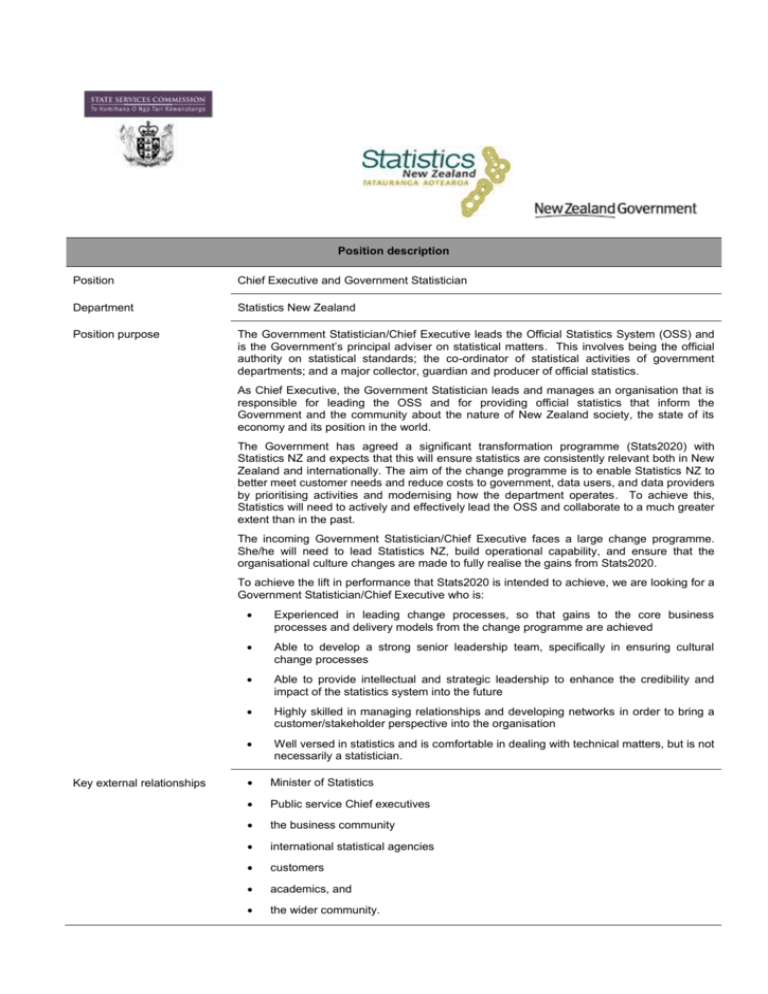
Position description
Position
Chief Executive and Government Statistician
Department
Statistics New Zealand
Position purpose
The Government Statistician/Chief Executive leads the Official Statistics System (OSS) and
is the Government’s principal adviser on statistical matters. This involves being the official
authority on statistical standards; the co-ordinator of statistical activities of government
departments; and a major collector, guardian and producer of official statistics.
As Chief Executive, the Government Statistician leads and manages an organisation that is
responsible for leading the OSS and for providing official statistics that inform the
Government and the community about the nature of New Zealand society, the state of its
economy and its position in the world.
The Government has agreed a significant transformation programme (Stats2020) with
Statistics NZ and expects that this will ensure statistics are consistently relevant both in New
Zealand and internationally. The aim of the change programme is to enable Statistics NZ to
better meet customer needs and reduce costs to government, data users, and data providers
by prioritising activities and modernising how the department operates. To achieve this,
Statistics will need to actively and effectively lead the OSS and collaborate to a much greater
extent than in the past.
The incoming Government Statistician/Chief Executive faces a large change programme.
She/he will need to lead Statistics NZ, build operational capability, and ensure that the
organisational culture changes are made to fully realise the gains from Stats2020.
To achieve the lift in performance that Stats2020 is intended to achieve, we are looking for a
Government Statistician/Chief Executive who is:
Key external relationships
Experienced in leading change processes, so that gains to the core business
processes and delivery models from the change programme are achieved
Able to develop a strong senior leadership team, specifically in ensuring cultural
change processes
Able to provide intellectual and strategic leadership to enhance the credibility and
impact of the statistics system into the future
Highly skilled in managing relationships and developing networks in order to bring a
customer/stakeholder perspective into the organisation
Well versed in statistics and is comfortable in dealing with technical matters, but is not
necessarily a statistician.
Minister of Statistics
Public service Chief executives
the business community
international statistical agencies
customers
academics, and
the wider community.
Performance profile
Medium-term priorities
Accountabilities
Operational accountabilities
Over the next five years the Government Statistician/Chief Executive is expected to set a
clear direction for the future and deliver results in the following areas:
complete key milestones towards the implementation of the new operating model
envisaged under Stats 2020, with a focus on achieving cultural change and building
capability that is fit for purpose now and in the future
ensure credibility of key statistics so that stakeholder confidence is maintained
drive collaboration across the Official Statistics System, and engage stakeholders in
contributing to maximising the benefits from Government’s investment in official
statistics and administrative data
improve relationships and strengthen customer service with respondents, users,
potential users and government agencies to ensure the quality and usefulness of
statistics
contribute to Better Public Service reform programme.
Excellent leadership by public service chief executives is essential to high performing
departments and a high performing public service. Chief executives are required to work
collaboratively in a spirit of service and strive towards the overall goal of a system of world
class, professional State Services, serving the government of the day and meeting the needs
of all New Zealanders. As a Chief Executive in the New Zealand Public Service you will be
accountable for:
the Department carrying out the purpose of the State Sector Act, the Public Finance
Act, the Statistics Act 1975 and other relevant statutes and legislation
the Department’s response on matters relating to the collective interests of government
the stewardship of the Department, including of its medium and long-term
sustainability, organisational health, capability, and capacity to offer free and frank
advice to successive Governments
the stewardship of the assets and liabilities that are used by or relate to the
Department, including the stewardship of the information collected and held by the
Department; and the legislation administered by the Department
giving effect to whole of government requirements on matters such as procurement,
property management, ICT, security and privacy
the performance of the functions and duties and the exercise of the powers of the
Department
the tendering of free and frank advice to Ministers
the integrity and conduct of the Department’s employees, and
the efficient and economical delivery of the services provided by the Department and
how effectively those services contribute to the intended outcomes.
The Government Statistician/Chief Executive is required to:
provide leadership for the Official Statistics System (OSS) to efficiently produce the
information New Zealand needs
provide excellent leadership and management of the department to ensure it has the
necessary capability to perform its role, including:
o
aligning the culture of the organisation with the new operating model
o
ensuring the right capability and relationships to deliver the new operating
model
o
building a responsive, customer-focused organisation with the capability to
influence across government agencies and the wider OSS
2
o
ensuring a long-term view is maintained so that Statistics NZ remains
current and reliable
advise the Minister of Statistics on statistical policy; the statistical needs of government,
the need for surveys or statistical collections, and statistical projects of government
agencies
promote and uphold the principles and protocols for official statistics
review the suite of official statistics to ensure they are fit for purpose
compile, analyse, abstract, and publish, with or without comments, official statistics
define and promote the use of standard statistical concepts, procedures, definitions and
classifications
examine and comment on the interpretation and validity of published statistics
conduct a Census of Population and Dwellings
member of the Ministerial Advisory Committee on Official Statistics (ACOS).
Person profile
Position specific
competencies
The behaviours1 below summarise the competencies which the Chief Executive and
Government Statistician, will need to demonstrate.
Operating skills
The Chief Executive will create focus within their organisations and get things done. They
find ways to eliminate roadblocks and zero in on the vital few issues that require their
attention. They understand organisational processes and identify systemic opportunities for
synergy and integration. They create strong teams by empowering people, fostering open
dialogue, effectively allocating resources and ensuring that individuals work together. They
use teams to work across boundaries and accomplish integrated tasks and sustained
coordinated efforts. In doing this, they continually support the development of their senior
team; coaching them and providing opportunities that will stretch them.
Strategic skills
The Chief Executive possesses a depth and breadth of knowledge. They are intellectually
sharp, and deal with concepts and complexity comfortably. They have a strong grasp of key
trends and issues facing their agency and the wider state sector, and develop long range
strategies and plans. They probe deeply into issues without losing sight of the bigger
picture. They learn quickly when facing new problems and are comfortable handling risk
and uncertainty. They are willing to experiment and are open to change. They are future
oriented and take a broad perspective on issues, analysing both successes and failures for
clues about how to improve. They create a compelling vision and inspire others to support
that vision.
Organisational positioning
skills
The Chief Executive will understand the political and organisational context within which
they work. They are sensitive to political processes and anticipate risks and how others may
respond. They can manoeuvre through complex political situations effectively and quietly
whilst maintaining Public Service standards of political neutrality. They know how to get
things done within the political and organisational context and understand the origin and
reasoning behind key policies, practices and procedures. They understand how to work with
different organisational cultures.
Energy and drive
The Chief Executive consistently demonstrates energy and drive for better results. They
don’t give up in the face of resistance or setbacks, however they are also willing to adapt
their approach if necessary to achieve the desired result. They consistently and constantly
strive for better performance, balanced with a concern for people and due process..
1
These skill descriptions are based on Lominger International’s LEADERSHIP ARCHITECT Competency Sort Cards, Copyright 1992, 1996,
2001-2003 Lominger Limited, Inc., a subsidiary of Korn/Ferry International ALL RIGHTS RESERVED, and are used with the express permission of
Lominger International.”
3
Personal and interpersonal
skills
The Chief Executive will have highly developed personal and interpersonal skills.
In terms of personal skills, they know themselves well, are open to criticism and seek
feedback. They learn from their mistakes and strive constantly to develop themselves. They
are adaptive. They can be counted on to remain calm and hold things together in tough
times. They are not prone to defensiveness, frustration, nor easily knocked off balance.
In their dealings with others they are good listeners and can easily establish rapport with
people from all walks of life. They are respectful toward others and hire for variety and
diversity. They build relationships of trust and respect with clients, colleagues, Ministers and
staff. They can be direct and diplomatic, and can resolve differences without damaging
relationships. They are collaborative and value others’ contributions. They create a climate
in which people feel motivated to do their best and people like working for and with them.
They are dedicated to meeting the expectations and requirements of Ministers and clients
and act consistently with those expectations and requirements in mind.
Courage
The Chief Executive can be counted on to step up when times are tough. They do not shirk
personal responsibility. They anticipate potential conflicts and make conscious choices
about the approach they will take. If conflict arises they look for common ground; resolving
differences equitably and calmly. They are willing to take the lead on controversial issues.
They read situations and people accurately. They are a good judge of people and are able
to clearly see their strengths and limitations.
Acting with honour and
integrity
The Chief Executive will adhere to the Standards of Integrity and Conduct for the State
Services, during both good and bad times. As well as taking a lead role in promoting the
Standards, they role model the ethics, values and behaviours set out in the Standards.
They deliver on their promises and are direct and truthful in their dealings with others. They
keep confidences and admit mistakes. They do not misrepresent themselves for personal
gain and are widely trusted.
Security Clearance
Appointment will be subject to a New Zealand Government Confidential security clearance.
Statutory Relationships
The Office of Government Statistician is established under section 13 of the Statistics Act
1975 and performs the duties of Government Statistician as laid out in section 14 of the Act.
The role and duties of chief executive are set out in the State Sector Act 1988 (especially
section 32), the Public Finance Act 1989 (especially section 33) and other relevant statutes
and legislation.
Under section 37 of the State Sector Act, the Chief Executive is appointed by the State
Services Commissioner who is responsible for managing the employment and reviewing
the performance of Public Service Chief Executives.
The relationship between the Minister of Statistics and the Government Statistician/Chief
Executive parallels that between other Ministers and their departments in terms of the
purchase of outputs by Government and the provision of advice. The Statistics Act defines
the independence of the Government Statistician in official statistics, and ensures that the
production and release of official statistics collected under this Act are not subject to
external pressures. This is essential to give confidence in the impartiality of statistics
produced. Section 15 of the Statistics Act states that the Government Statistician:
shall have the sole responsibility for deciding the procedures and methods employed
in the provision of any statistics produced or to be produced by the Statistician, and
shall also have the sole responsibility for deciding the extent, form, and timing of
publication of those statistics.
The Government Statistician is required to be a member of the Representative Commission
(s2 Electoral Act 1993).
4
The Government Statistician also complies with the requirements and intent of the Privacy
Act 1993, which contains a number of principles on the privacy of individuals. Other
legislation particularly affecting the Government Statistician includes:
Official Information Act 1982
Local Electoral Act 2001.
Information on Statistics New Zealand outcomes, organisational structure, dimensions and appropriations can be found
in the Statement of Intent 2012-17 and the Annual Report 2012. The following links are to these documents on the
Statistics New Zealand website:
http://www.stats.govt.nz/about_us/our-publications/annual-reports.aspx
http://www.stats.govt.nz/about_us/our-publications/statement-of-intent.aspx
Further information on Statistics New Zealand can be found on the Ministry’s website in the Briefing to the Incoming
Minister, December 2011:
http://www.stats.govt.nz/about_us/our-publications/briefings-to-the-incoming-minister.aspx
5

